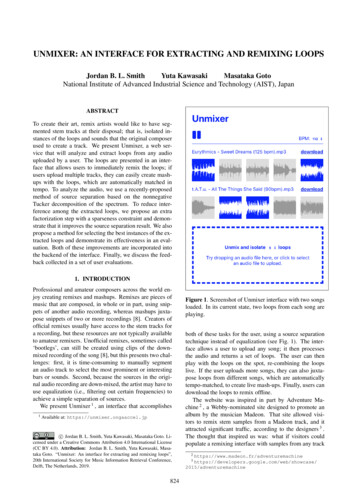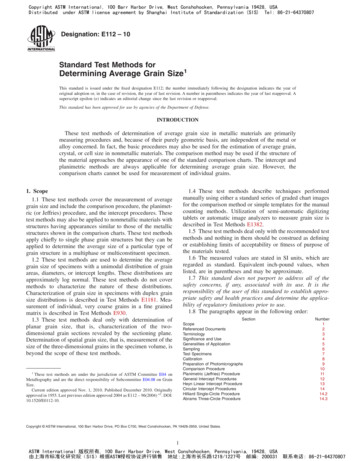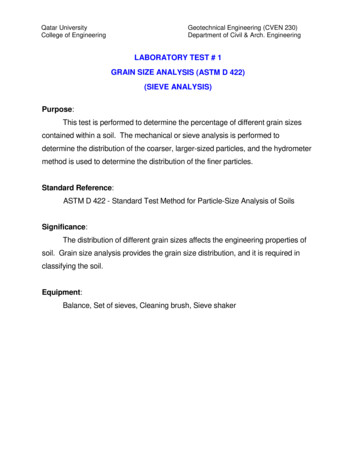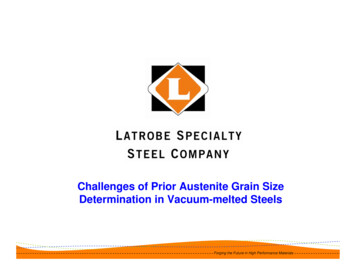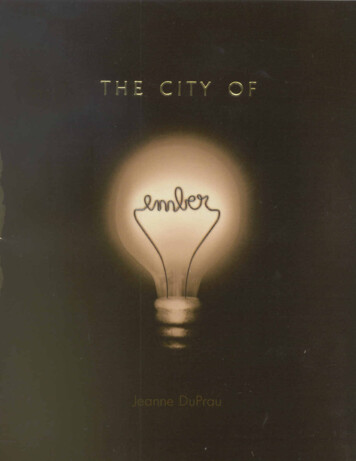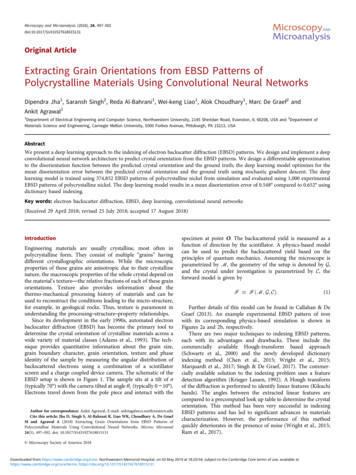
Transcription
Microscopy and Microanalysis (2018), 24, 497–502doi:10.1017/S1431927618015131Original ArticleExtracting Grain Orientations from EBSD Patterns ofPolycrystalline Materials Using Convolutional Neural NetworksDipendra Jha1, Saransh Singh2, Reda Al-Bahrani1, Wei-keng Liao1, Alok Choudhary1, Marc De Graef2 andAnkit Agrawal11Department of Electrical Engineering and Computer Science, Northwestern University, 2145 Sheridan Road, Evanston, IL 60208, USA and 2Department ofMaterials Science and Engineering, Carnegie Mellon University, 5000 Forbes Avenue, Pittsburgh, PA 15213, USAAbstractWe present a deep learning approach to the indexing of electron backscatter diffraction (EBSD) patterns. We design and implement a deepconvolutional neural network architecture to predict crystal orientation from the EBSD patterns. We design a differentiable approximationto the disorientation function between the predicted crystal orientation and the ground truth; the deep learning model optimizes for themean disorientation error between the predicted crystal orientation and the ground truth using stochastic gradient descent. The deeplearning model is trained using 374,852 EBSD patterns of polycrystalline nickel from simulation and evaluated using 1,000 experimentalEBSD patterns of polycrystalline nickel. The deep learning model results in a mean disorientation error of 0.548 compared to 0.652 usingdictionary based indexing.Key words: electron backscatter diffraction, EBSD, deep learning, convolutional neural networks(Received 29 April 2018; revised 25 July 2018; accepted 17 August 2018)IntroductionEngineering materials are usually crystalline, most often inpolycrystalline form. They consist of multiple “grains” havingdifferent crystallographic orientations. While the microscopicproperties of these grains are anisotropic due to their crystallinenature, the macroscopic properties of the whole crystal depend onthe material’s texture—the relative fractions of each of these grainorientations. Texture also provides information about thethermo-mechanical processing history of materials and can beused to reconstruct the conditions leading to the micro-structure,for example, in geological rocks. Thus, texture is paramount inunderstanding the processing–structure–property relationships.Since its development in the early 1990s, automated electronbackscatter diffraction (EBSD) has become the primary tool todetermine the crystal orientation of crystalline materials across awide variety of material classes (Adams et al., 1993). The technique provides quantitative information about the grain size,grain boundary character, grain orientation, texture and phaseidentity of the sample by measuring the angular distribution ofbackscattered electrons using a combination of a scintillatorscreen and a charge coupled device camera. The schematic of theEBSD setup is shown in Figure 1. The sample sits at a tilt of σ(typically 70 ) with the camera tilted at angle θc (typically 0 10 ).Electrons travel down from the pole piece and interact with theAuthor for correspondence: Ankit Agrawal, E-mail: ankitag@eecs.northwestern.eduCite this article: Jha D, Singh S, Al-Bahrani R, Liao WK, Choudhary A, De GraefM and Agrawal A (2018) Extracting Grain Orientations from EBSD Patterns ofPolycrystalline Materials Using Convolutional Neural Networks. Microsc Microanal24(5), 497–502. doi: 10.1017/S1431927618015131specimen at point O. The backscattered yield is measured as afunction of direction by the scintillator. A physics-based modelcan be used to predict the backscattered yield based on theprinciples of quantum mechanics. Assuming the microscope isparametrized by M, the geometry of the setup is denoted by G,and the crystal under investigation is parametrized by C, theforward model is given byF FðM; G; CÞ:(1)Further details of this model can be found in Callahan & DeGraef (2013). An example experimental EBSD pattern of ironwith its corresponding physics-based simulation is shown inFigures 2a and 2b, respectively.There are two major techniques to indexing EBSD patterns,each with its advantages and drawbacks. These include thecommercially available Hough-transform based approach(Schwartz et al., 2000) and the newly developed dictionaryindexing method (Chen et al., 2015; Wright et al., 2015;Marquardt et al., 2017; Singh & De Graef, 2017). The commercially available solution to the indexing problem uses a featuredetection algorithm (Krieger Lassen, 1992). A Hough transformof the diffraction is performed to identify linear features (Kikuchibands). The angles between the extracted linear features arecompared to a precomputed look up table to determine the crystalorientation. This method has been very successful in indexingEBSD patterns and has led to significant advances in materialscharacterization. However, the performance of this methodquickly deteriorates in the presence of noise (Wright et al., 2015;Ram et al., 2017). Microscopy Society of America 2018Downloaded from https://www.cambridge.org/core. Northwestern Memorial Hospital, on 03 May 2019 at 18:20:54, subject to the Cambridge Core terms of use, available athttps://www.cambridge.org/core/terms. https://doi.org/10.1017/S1431927618015131
498Dipendra Jha et al.pole piecesampleNDYOLP ZRDD cscintillatorFigure 1. Schematic of the electron backscatter diffraction geometry.In essence, dictionary based indexing is a nearest neighborsearch approach in which the output angles correspond to theorientation angles of the closest EBSD pattern present in dictionary. The distance function used is a dot product as follows:x2 Þ 1 dð x1 ; x2x1 ;j x1 j j x2 j(2)where !x is a vector representing the pixels in the EBSD patterns.The dot product between the pixel intensities in the test sampleand each sample in the simulation-based dictionary set is computed and the nearest training sample is used to make the prediction. This method has been shown to be very robust to noise inthe diffraction pattern and outperforms the line feature basedHough transform method (Ram et al., 2017) for a wide variety ofcrystal classes. However, this approach is computationally veryexpensive, which limits the technique to be an off-line method,and a real time solution to the indexing problem is currently notpossible using this approach.In the present paper, we present a deep learning (LeCun et al.,2015) based model, trained using a simulated diffraction dataset,to predict the crystal orientations for experimental EBSD patterns, such that they have a minimum “disorientation” withrespect to their ground truth. Deep learning leverages deep neuralnetworks composed of multiple processing layers to automaticallylearn the representations of data with multiple levels of abstraction (LeCun et al., 2015). They have achieved great success in thefield of computer science with state-of-the-art results in computervision (Krizhevsky et al., 2012; Szegedy et al., 2017), speechrecognition (Mikolov et al., 2011; Deng et al., 2013) and textprocessing (Sutskever et al., 2014), and are increasingly being usedin the relatively nascent field of materials informatics (Agrawal &Choudhary, 2016) for deciphering processing–structure–propertyrelationships.A convolutional neural network (CNN) is a type of artificialneural network which is composed of convolution layers (LeCun,2015) in addition to fully connected layers. Since they requireminimal preprocessing, they have gained significant attention infields like computer vision (Krizhevsky et al., 2012; Szegedy et al.,2017), recommender system (Van den Oord et al., 2013) andnatural language processing (Collobert & Weston, 2008).Recently, CNNs have been applied for building models frommicrostructural data and improving characterization methods(Kondo et al., 2017; Cecen et al., 2018; Ling et al., 2017) and theyhave been shown to be useful for predicting properties of crystalstructures and molecules (Schütt et al., 2018; Wu et al., 2018),detecting cracks in materials/infrastructure images (Gopalakrishnanet al., 2017), and so on. Park et al. (2017) used CNNs for theclassification of X-ray diffraction (XRD) patterns in terms ofcrystal system, extinction group and space group using a largedataset of 150,000 XRD patterns, without any manual featureengineering. Xu & LeBeau (2018) developed CNNs to automatically analyze position averaged convergent beam electrondiffraction patterns to extract pattern size, center, rotation, specimen thickness, and specimen tilt, without any need for pretreating the data. Liu et al. (2016) applied CNNs to learn crystalorientations from simulated EBSD patterns; they built threeseparate CNN models to individually predict the three Eulerangles, but did not take into account the mean disorientationbetween the predicted and true crystal orientations. Moreoever,their models were not tested on experimental data. In this study,our goal is to learn to predict the crystal orientation of experimental EBSD patterns such that they have minimum disorientation with the ground truth.Building a predictive model for the indexing of EBSD patternsposes two significant challenges. First, we need to minimize thedisorientation between the predicted and the ground truth crystalorientations; this requires optimizing for the mean disorientationerror which is metric for a highly nonlinear orientation space.Furthermore, this cost function is computationally intensive,making it difficult to manually compute and implement itsderivatives with respect to the orientation angles. Therefore, wedesigned a differentiable approximation to the mean disorientation; it is implemented using TensorFlow (Abadi et al., 2016) andoptimized using stochastic gradient descent (Bottou, 1991). Thetraining of the deep learning model was optimized to takeadvantage of the parallelization available in graphics processingunits (GPUs) to process a complete mini-batch.The second challenge is that the crystal orientation is represented using three Euler angles, which requires learning all threeangles simultaneously using a single model, which is differentfrom multi-labeling problems that require predicting differentobjects present in the input image (Zhou et al., 2008; Briggs et al.,2013; Pham et al., 2015). Most state-of-the-art deep learningarchitectures are limited to predicting a single output (Krizhevskyet al., 2012; He et al., 2016; Szegedy et al., 2017); existing work onmulti-output learning using neural networks has been limited toabFigure 2. Electron backscatter diffraction pattern from iron (a) experimental and (b)simulation.Downloaded from https://www.cambridge.org/core. Northwestern Memorial Hospital, on 03 May 2019 at 18:20:54, subject to the Cambridge Core terms of use, available athttps://www.cambridge.org/core/terms. https://doi.org/10.1017/S1431927618015131
Microscopy and Microanalysisshallow feed-forward networks with a single regression layerhaving multiple outputs (Kang et al., 1996; An et al., 2013;Bezijglov et al., 2016).We design and implement a novel branched deep CNNoptimized for learning multiple outputs; we refer to this model asOMNet. The training and test sets are composed of EBSD patterns of polycrystalline nickel. The simulation dataset used fortraining the models is composed of 374,852 EBSD patterns. Themodels are evaluated using a set of 1,000 EBSD patterns from realexperiments. The OMNet model outperforms the current dictionary based indexing by 16%, resulting in a mean disorientationof 0.548 compared to 0.652 for the dictionary approach.Crystal Orientation and DisorientationThe orientation of a crystal is represented by a passive 3D rotaright-handed Cartesiantion, g, which maps the specimen’s coordinate frame, es es1 ; es2 ; es3 onto a right-handed Cartesian coordinate system attached to the crystal, ec ec1 ; ec2 ; ec3 , suchthat eci gij esj ; in this representation, the orientation g corresponds to a 3 3 special orthogonal matrix, that is, an element ofSO(3). There are numerous other representations for orientations,such as the unit quaternion, Rodrigues–Frank vectors, axis-anglepair and cubochoric vector; each with its own distinct propertiesand advantages. Furthermore, all crystals have certain symmetriesassociated with them, which lead to degeneracies such that allcrystal orientations are not unique. For any crystal, let Ocrepresent the set of symmetry operators including the identityoperation, with cardinality # Oc N. All orientations in the setOc g are equivalent for this crystal symmetry and representidentical orientations.In the absence of crystal symmetry, the distance metricbetween two orientations g1 and g2 is represented by Dðg1 ; g2 Þ,and is referred to as the misorientation. This metric represents theangle of rotation about some axis to go from one crystal orientation to the other. In this case, the space has simple analyticalexpressions for the metric tensor as well as smooth and continuous geodesics. The distance metric is given by (assuming g isin matrix notation) (3)Dðg1 ; g2 Þ arccos tr g 11 g2 1 2 :However, in the presence of crystal symmetry, the rotationspace becomes degenerate and such an expression is no longervalid. In the presence of crystal symmetry given by the set Oc , thedistance metric referred to as disorientation is given by the following expression (assuming g and Oc are both in matrix notation):n h 1 j i Oc g2 1 2 ;Dðg1 ; g2 Þ min arccos tr Oic g1i;j2½1;N h 1 j i oð4ÞOc g1 1 2 :arccos tr Oic g2This expression gives the minimum angle of rotation, that is,the disorientation, about some axis between any two symmetrically equivalent variants of the two orientations g1 and g2.Deep Learning ApproachThe ideal data driven approach for building a predictive modelwould be to train a machine learning model on the EBSD patternsfrom experiments. However, experiments are generally expensive499and yield a relatively small number of diffraction patterns; in ourcase, we have s
used to reconstruct the conditions leading to the micro-structure, for example, in geological rocks. Thus, texture is paramount in understanding the processing–structure–property relationships. Since its development in the early 1990s, automated electron backscatter diffraction (EBSD) has become the primary tool to determine the crystal orientation of crystalline materials across a wide .

